There isn’t anything better than a good raspberry.
I bet you’ve never had one.
The ones you find at the supermarket, the ones in plastic clamshell packaging came from large corporate farms will never taste like what you can grow.
They are harvested with big machines that don’t care if the berry is ripe. They’re going for quantity and that’s the problem with BigAg.
A good raspberry is still warm from the sun after you pluck it from the prickly bramble.
We grew raspberries for sale at farmers market for 12 years. COVID took us out…
We’ve learned a thing or two.
Here’s some information for anyone interested in growing raspberries.
About our Farm
We are a biodynamic farm that utilizes permaculture techniques and forest stewardship council practices.
Biodynamic farming methods work off the concept that a farm is a site-specific ecosystem. Biodynamic farming is a holistic system that places importance on all of a farm's elements: soil, water, plants & animals. These methods rely heavily on soil building, water conservation, composting, animal production and animal by-products. Not all growers using biodynamic techniques adhere to the complete biodynamics program. You can be certified, but you do not need to be certified to be considered a biodynamic farm.
Permaculture technique include a design system that creates a sustainable food production environment. This environment begins with soil building, uses specific site design with a focus of more perennial plants less annuals, utilizes high density growing, companion planting and compost production and vermiculture. These techniques encourage growing more food in less space.
Forest Stewardship Council Practices (FSC)
Encourages the efficient use of the forest’s multiple products; Conserves biological diversity and its associated water resources, soils, and unique and fragile ecosystems and landscapes; Monitors the condition of the forest & maintains the health of the forest.
Although not certified organic, we followed natural, organic, sustainable farming techniques and environmental designs that rely on all natural methods. Some of the permaculture techniques we implemented: high density growing, composting, & vermiculture, companion planting, weed burning, and integrated pest management(IPM). We followed forest stewardship council (FSC) practices to maintain our farm's forest productivity and safe water. We drip irrigated all of our crops which reduced plant stress, resulting in a decrease in pest and disease problems as well as increasing the quality and size of our crops.
Our farm is surrounded mostly by cattle and hog farmers so harmful pesticides that float from one farm to another was not an issue with our fresh product production. Rain and sunshine are the primary environmental elements our crops are exposed to. We used natural remedies when necessary, and the majority of our crops were not sprayed at all.
All of our irrigation needs were supplied by rain or our pond. Our farm is approximately one mile off the road away from “grid” services such as electricity and water. This led us on any number of alternative pursuits and solutions other farmers might take for granted. When you plan to install an acre of raspberries and an acre of herbs, not to mention personal vegetable gardens and fruit trees, you have to think about irrigation first.
We were able to draw 2500 gallons of water from our pond to irrigate everything. This would not have been possible without the clever engineering, gravity and fluid dynamics we became so fond of.
Our irrigation involved pumping water uphill, filling multiple tanks along the way. We had nine 275 gallon tanks spread along our irrigation path. Four "stations" and a base station each serving a different purpose.
Base station was at the edge of the pond where the water was drawn.
Station one was approximately 50 feet uphill where the pond water was filtered with a sand filled pool filter and sent to the other stations.
Station two was at the same level approximately 50 feet to the left to line up with a direct path to the field.
Station three, was about 250 feet uphill consisted of three tanks. One holding tank for water transfer to station four tanks above the raspberry field and two holding tanks for the drip systems down hill in the herb gardens.
Station four was four tanks above the raspberry field. We counted on gravity to deliver the water to the raspberries via drip lines.
The placement of the tanks was very important for gravity to work. By placing the tanks higher on the slope than the gardens to be irrigated, we had enough water pressure to run sprinklers as needed, but more importantly, to need pressure reducing valves and heads for each drip zone.
We were successful in being able to provide an inch-two inches of water to the raspberries (in addition to rainwater) all season as well as being able to water all the herb beds as often as we needed.
Planning
It is important to plan where you'll be planting your raspberries. Try to avoid areas where previous crops have included strawberries, brambles, potatoes, tomatoes, eggplants, or peppers. These crops may harbor soil pathogens, which will affect the health and growth of your new plants.
Also plan for irrigation or water supply.
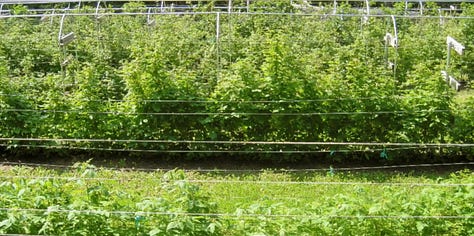
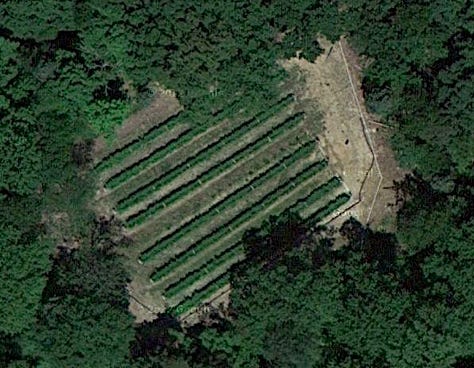
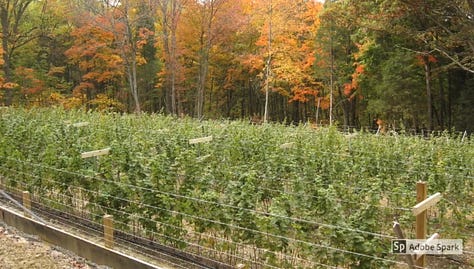
Our field was once forest.
We began clearing the field for red raspberry production in 2010. We determined we needed one acre of our 10 acres for raspberry production. We accomplished this by removing a band of red cedars on the hill side. The field is terraced and uphill from the pond.
Once the fields were cleared we installed the bare root red raspberry canes. Varieties we installed over the years: Killarney, Boyne, Encore, Prelude.
We always had Killarney and Encore. They performed the best.
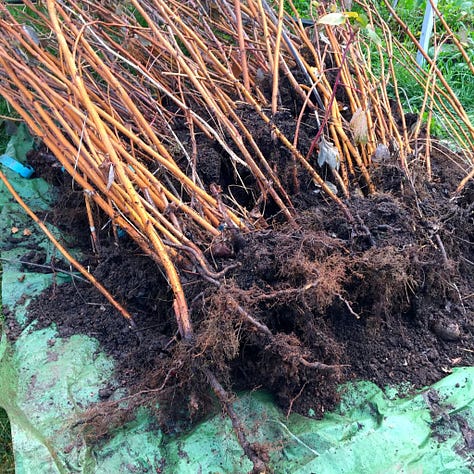
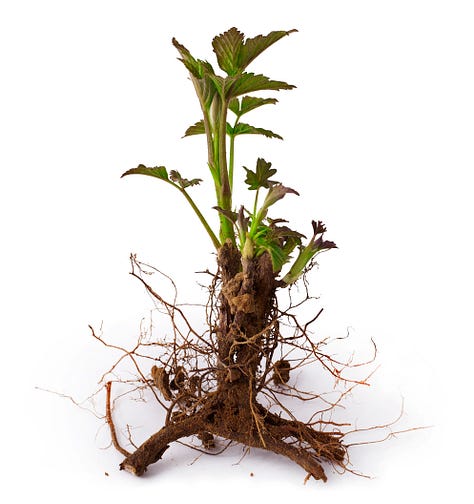
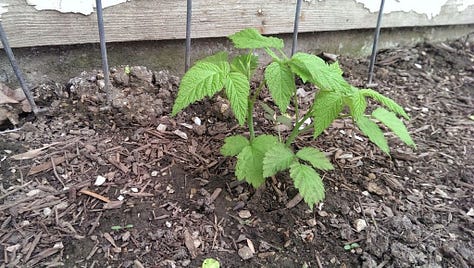
Installation
We installed 400-700 bare root plants that first year. It was just the two of us, it poured rain, it thunder stormed, some of the field shifted.
It was hard work but worth it.
We were the only small fruit vendors at markets and were able to charge $6.00 a pint. On average we took 200-500 pints per weekend (Sunday market) for the month of June into July, about 5 weeks. With over ripe berries I made jam, sauce and raspberry vinegar charging $5, $7 and $7 respectively.
It was good math and mostly covered our inputs.
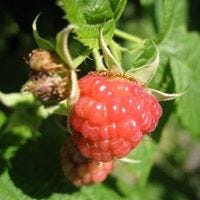
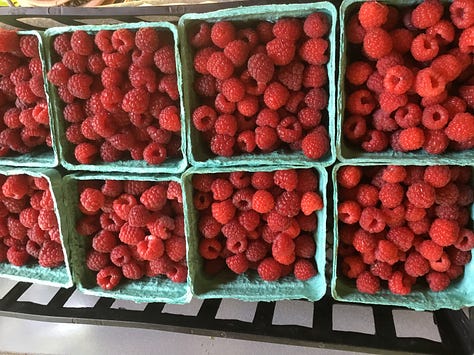
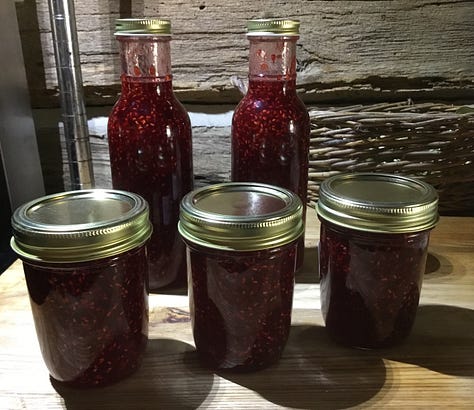
If the soil is not well-drained, raise the soil height of the planting rows or build twelve to eighteen inches (12–18") wide raised beds. We started with a blend of mounded soil composed of compost, sand and amended soil right on the native soil and then after a few years went to raised beds.
A soil test is important if you’re planting in native soil.
We found our raspberries loved a neutral to slightly acidic soil.
Plant as soon as possible in the spring, after your soil has warmed to 50°F. Planting too early, in cool, damp soil can delay development or cause roots to rot.
We installed dormant, bare-root raspberry plants. With these you use a hoe to make a two-inch deep trench the length of the bed. Lay the roots horizontally along the trench, two inches (2") deep. You may need to position some canes deeper than two inches (2") so that all roots on the cane are covered, still laying the length of the roots parallel to the soil surface at the two-inch (2") depth. Cover them immediately. If the bare roots are set too deeply, they will not easily send up new canes and potentially die.
New growth may not appear for five to six weeks. The cane portion of the plant sometimes does not leaf out and most, if not all new growth comes from the roots.
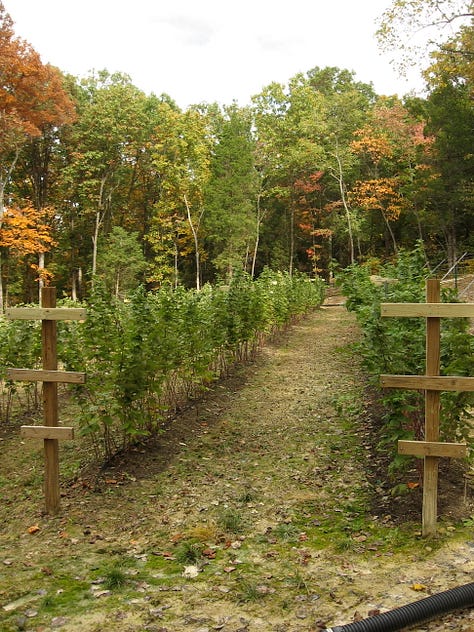
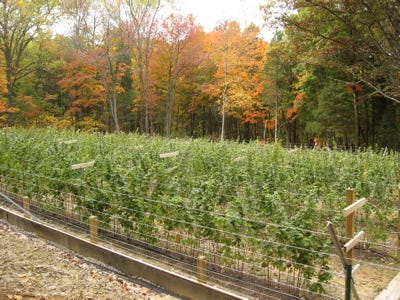
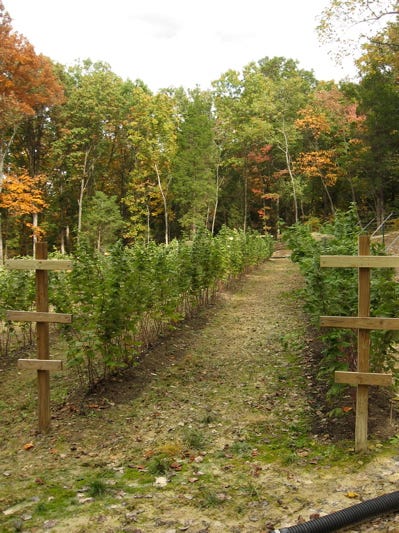
Trellising
Brambles need to be supported by a trellis. A trellis keeps canes upright and fruit off the ground, makes picking far easier, reduces wind damage and maintains good aeration throughout the planting which helps with disease and certain pests.
We were successful using a T-trellis which supported two wires 18” apart at 3.5’-5’ above the ground with post every 15’-25’. Our rows were 100’ so we had pressure treated 4” x 4” end posts.
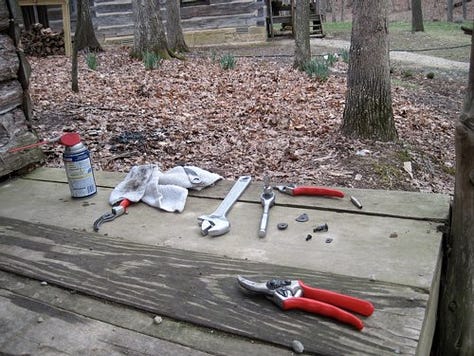

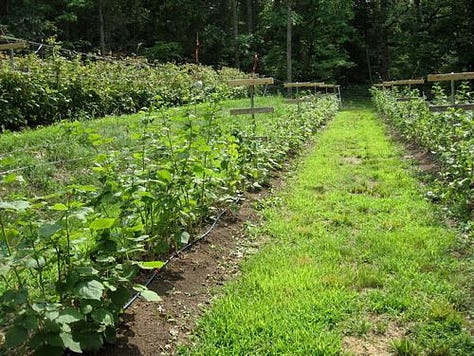
Pruning
We had floricane berry plants. Floricane bearing red raspberry varieties carry one crop of berries during the summer on over-wintered canes. After harvest, we cut the canes that carried fruit as close to the ground as possible and thinned the remaining new growth to six to eight strong, healthy canes per running foot of row.
Water Requirement - Irrigation
Water thoroughly after planting and maintain good soil moisture until plants are well established. The plants should receive one to two inches of rainfall or the equivalent each week throughout the season. Raspberries do not like to have wet feet, meaning the soil around the plants should dry out completely before watering again.
Fertilizing
Raspberries will suck all of the nutrients out of the soil if you don’t keep track of what’s going on.
The plants will tell you by how they look.
So will a soil test.
But as a general rule of thumb, incorporate a light amount of fertilizer at least two weeks prior to planting. Do not fertilize when planting, wait until new transplants are well established. For optimum growth and production, apply ½ lb. – ¾ lb. of 10-10-10 fertilizer per 100 sq. ft. each spring and an additional one (1) lb. of 10-10-10 fertilizer per 100 sq. ft. in mid-summer. Do not fertilize after July 1, as late fertilization generates tender new growth which will be more susceptible to winter injury.
Mother Nature & Pests
Raccoons, deer, birds, insects all LOVE raspberries. What does one do when Mother Nature loves to work against you?
Deer were a huge problem and we needed to protect our raspberries from them.
We talked with other farmers, no one had a good answer. It wasn't until one of our neighbors told us how deer had eaten all of his very large garden in one night leaving him with nothing that we realized we needed to find an answer.
We did some research and found an interesting solution. A slanted solar powered electric fence.
Deer can’t adjust their perception with a slanted fence. Raccoons are afraid of an electric fence.
The first time we went to the local feed store owner to ask him for parts we needed, he scratched his head and said "you want to do what?". He really was a good sport and helped us immensely with our crude drawings and almost baked solutions. We built a new twist on the solar powered electric fence. And not one critter foot print in the fields, no deer, no turkeys, not even raccoons after that.
Birds however were another problem...
The county where our farm is located is home to some of the prettiest birds and some of the largest. Two in particular loved to claim our raspberries, woodpeckers (Pileated and Northern Flicker) and Blue Jays.
Not graceful critters by any means, they are pretty clumsy in claiming the berries, as they massively destroy the growth around them. At one point another farmer had described his disgust in dealing with raspberries asked us if we had had any bird damage. We more or less said "What are you talking about?".
We quickly found out:
They were very destructive, these pictures don’t show the true horror.
Our answer.
Yards and yards of bird netting. Made harvesting very time consuming and difficult.
It was fun to defeat the birds though.
I can’t tell you how many times I heard “Mother Nature is such a Bi**ch.”
As our field was cut into a wooded slope and terraced, we experienced a pretty awesome mudslide in the upper side of the field. We knew eventually we'd have to deal with the issue, rain in 2011 forced the issue.
The mudslide and water almost caused us to lose a whole row of raspberry plants.
In two very condensed, very wet weeks we installed a four foot by 110ft retaining wall. Most of it done in pouring rain. A French drain was installed behind the wall in pea gravel.
Mudslides and standing water were issues until 2014.
You may not have these issues, but Mother Nature will deal you a hand to play if you dabble in raspberry growing!
Farmer Humor
From our Facebook page:
We pruned raspberry plants every year in July and August. Every year I said “this seems like such a waste throwing all these raspberry canes away”.
We were thinking about a new product line… think it will sell?
Got a ton of likes.
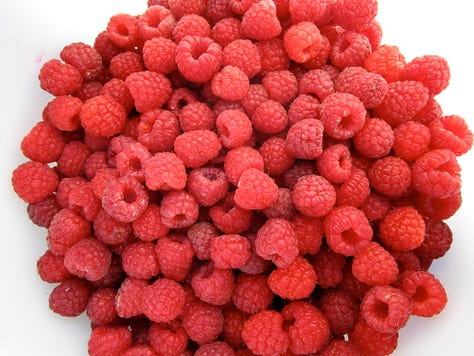

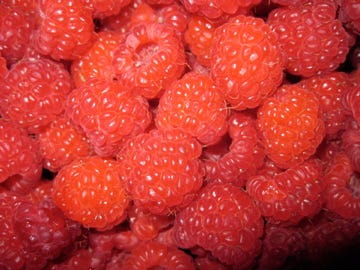
I hope if you are considering growing raspberries, my notes will help you be successful.
If you have questions I’ll try to answer them.


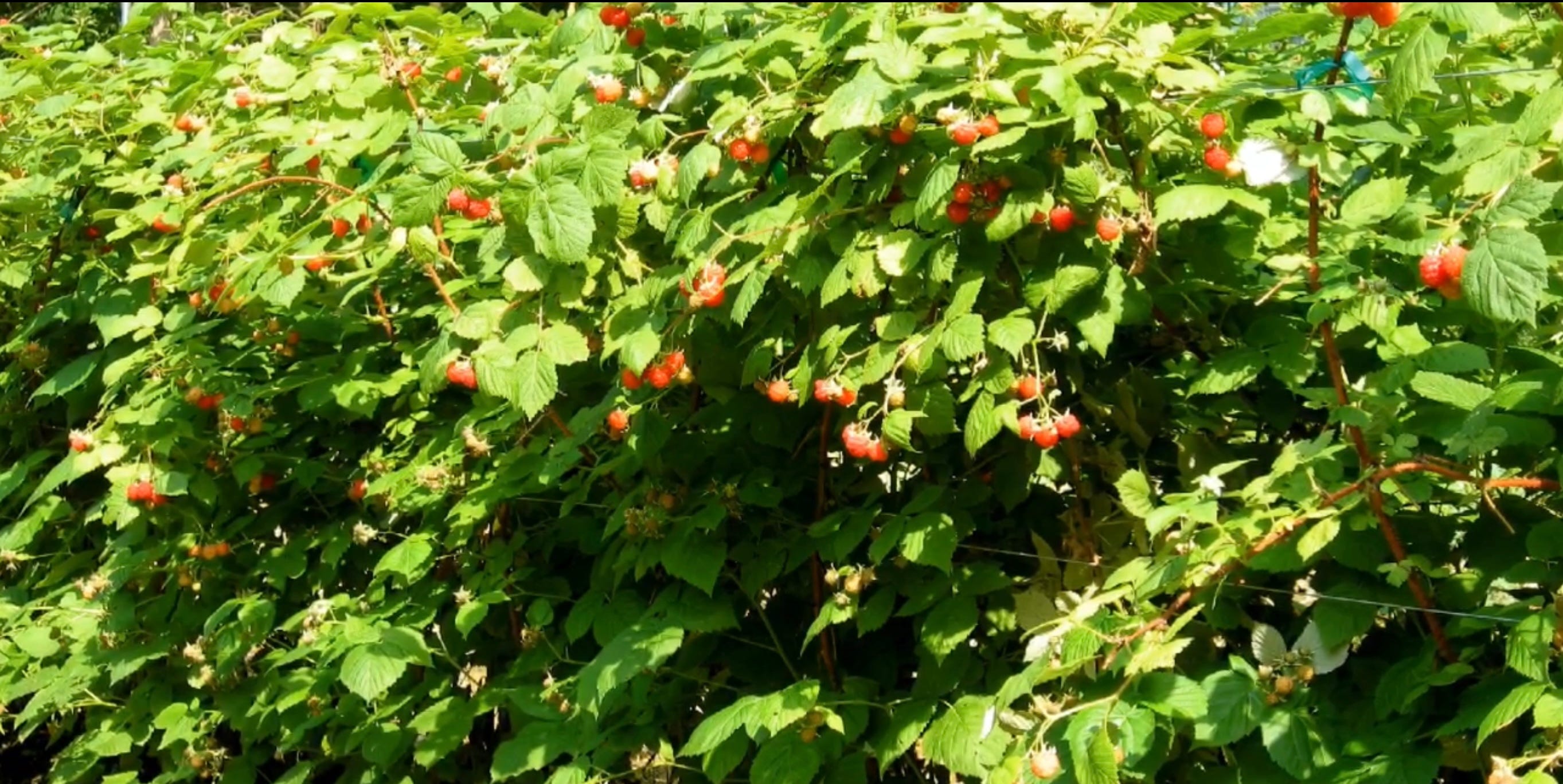
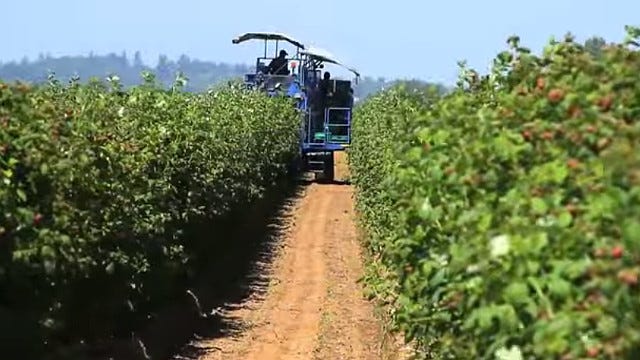
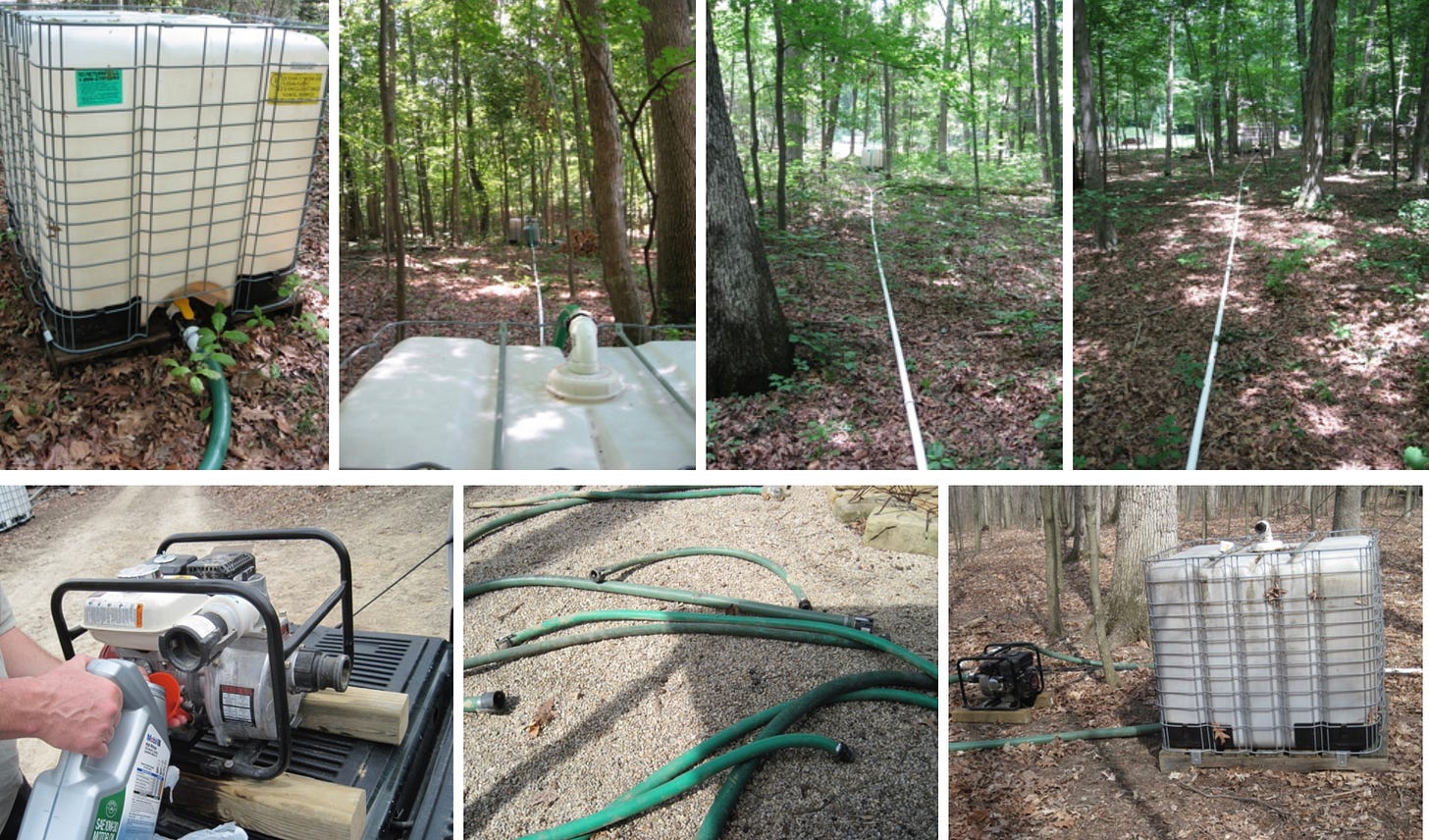
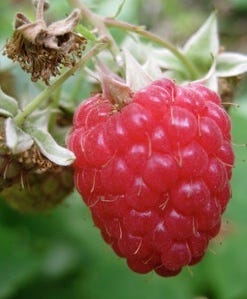
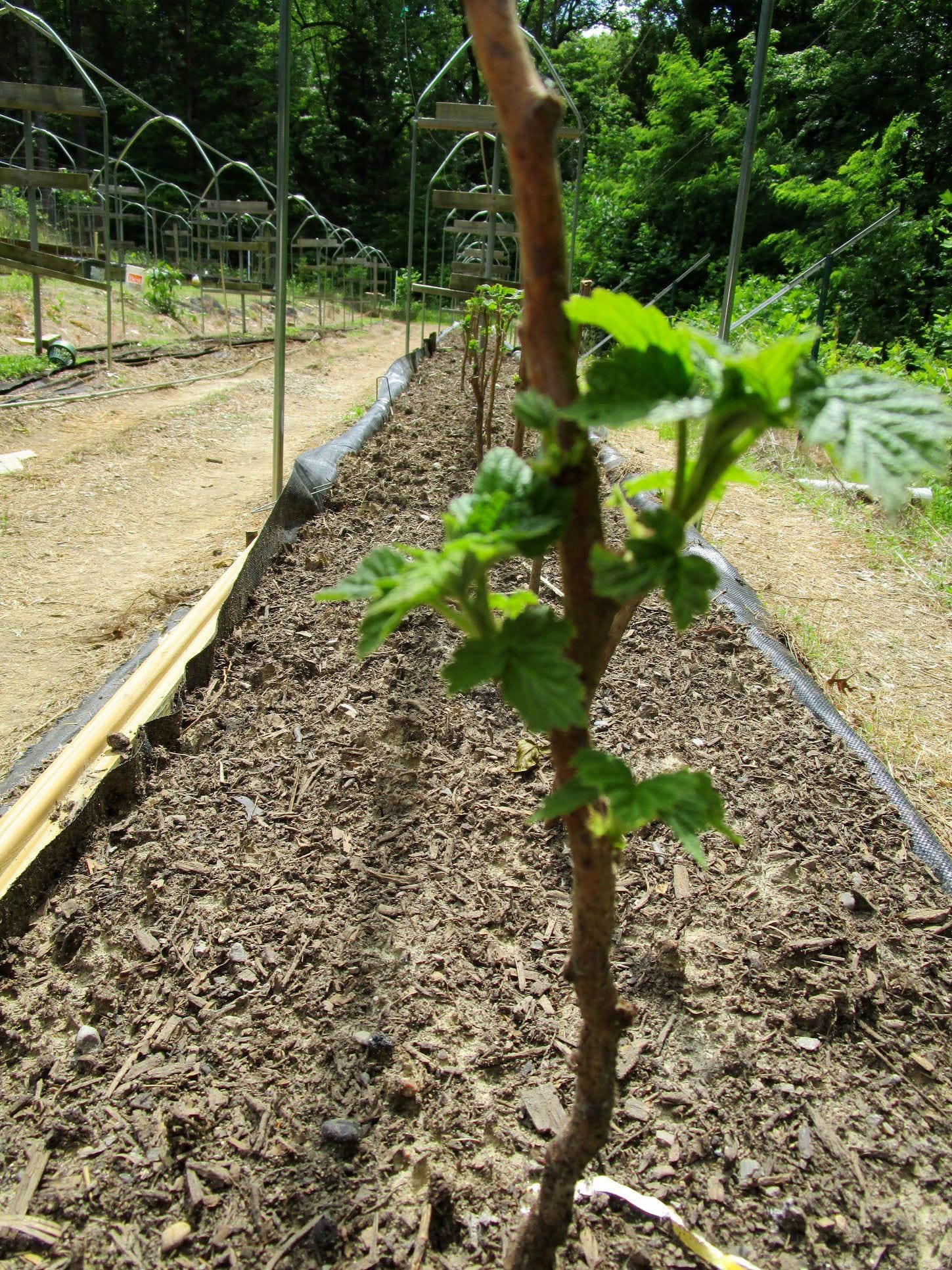
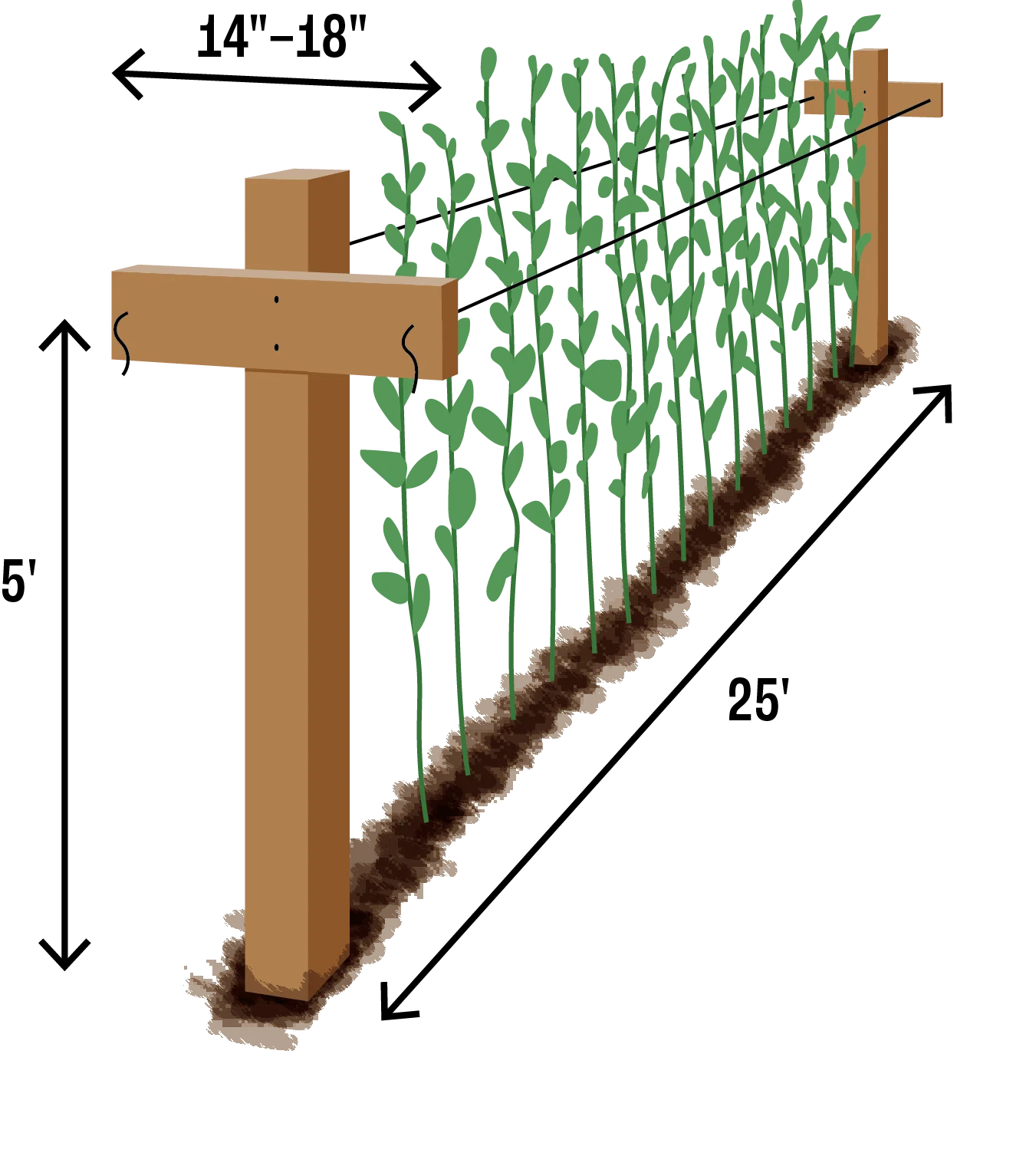
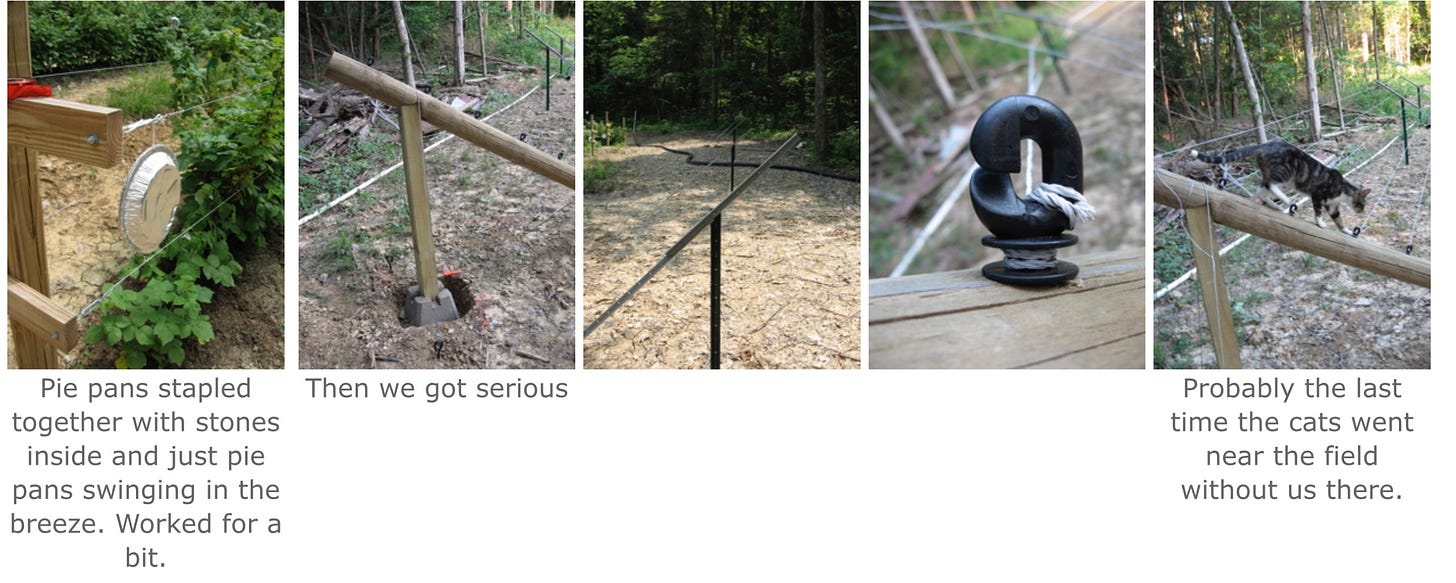

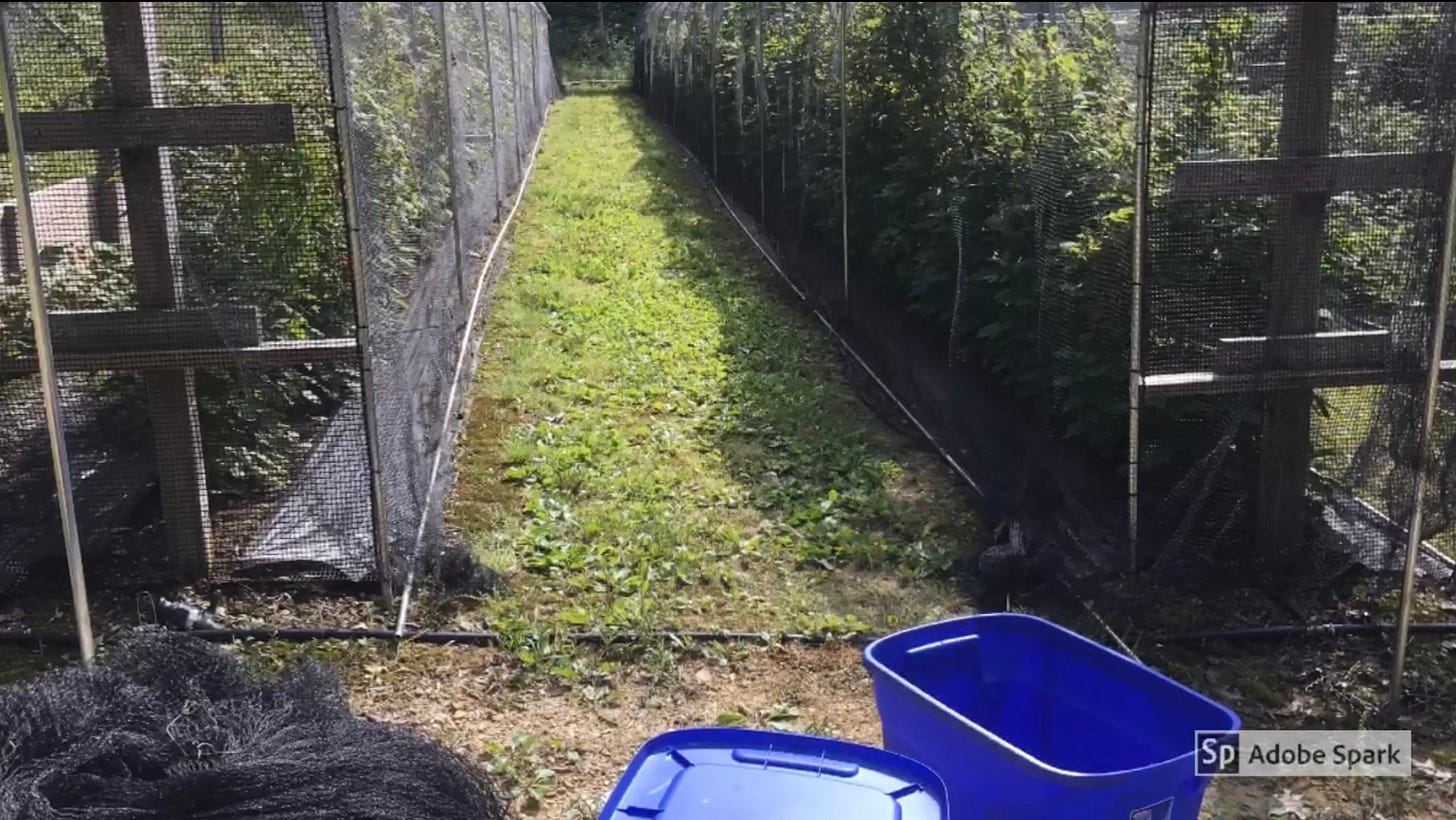
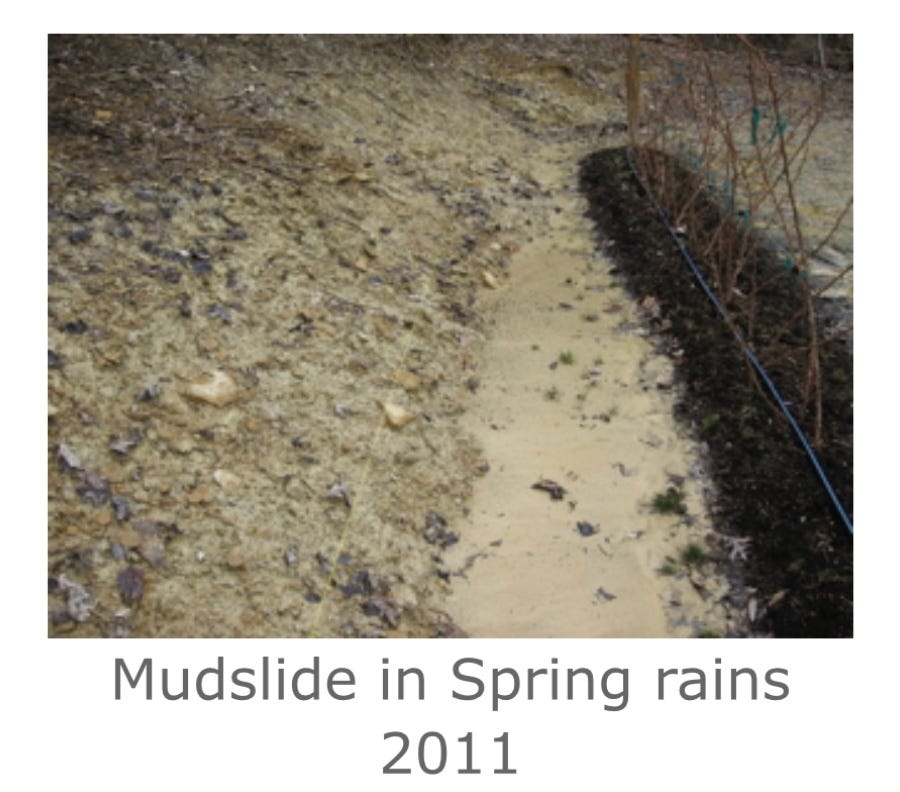
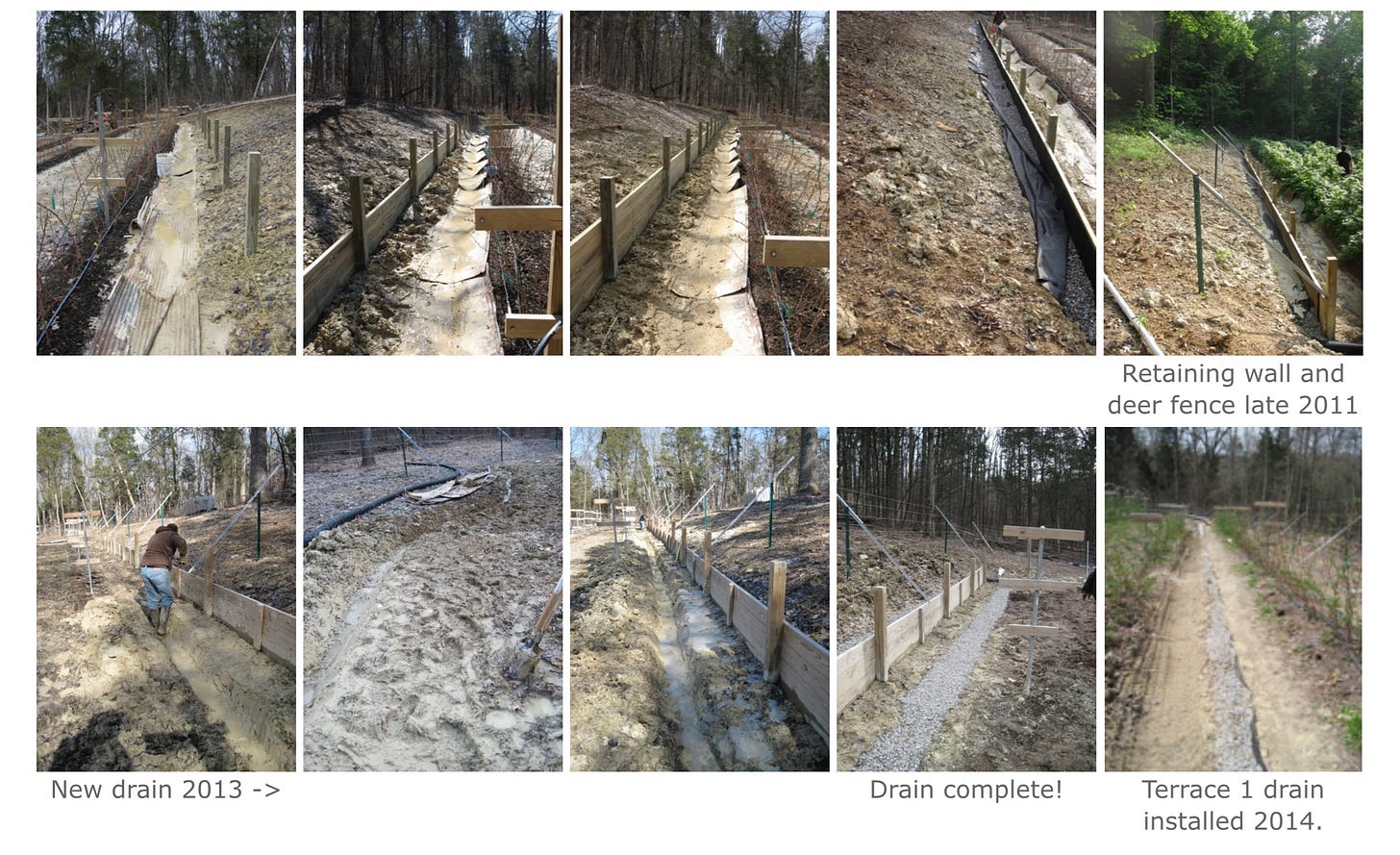

Collette, I’ve been reading your stuff for what, 3 years now? And not once did I have any idea that you operated a biodynamic raspberry farm!!! I’m blown away and I wish you were still doing it because I’d come buy your berries in a minute. Where was it? Our neighbors used to grow raspberries in their back yard here east of Everett, Washington, and they’d beg us to come pick them and we did, but they still produced way more than we could consume.
I admire your tenacity for the lovely queen of berries! In my mind anyway. A wild organic raspberry is the tastiest berry out there. Growing up my grandparents grew raspberries and my dad always had raspberry pie instead of cake for his birthday. To this day I still grow raspberries around my yard for the birds. I also love to pick them and make jam!!